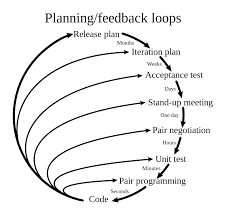Lean software development is a methodology that focuses on minimizing waste and maximizing value in the software development process. It is based on the principles of lean manufacturing, which were developed by Toyota in the 1950s. The goal of lean software development is to create high-quality software that meets customer needs while reducing costs and increasing efficiency.
One of the key principles of lean software development is to eliminate waste. This includes any activity that does not add value to the customer, such as unnecessary documentation or meetings. By eliminating waste, developers can focus on creating software that meets customer needs and delivers value.
Another principle of lean software development is to build quality into the process from the beginning. This means that developers should focus on preventing defects rather than fixing them after they occur. By building quality into the process, developers can reduce costs and improve efficiency.
Lean software development also emphasizes continuous improvement. Developers should constantly be looking for ways to improve their processes and deliver better value to customers. This can be achieved through regular feedback from customers and team members, as well as by measuring and analyzing key metrics.
One of the key benefits of lean software development is its focus on customer value. By prioritizing customer needs and delivering high-quality software quickly, developers can create a competitive advantage for their organization. Additionally, by eliminating waste and focusing on efficiency, organizations can reduce costs and increase profitability.
In order to implement lean software development successfully, organizations must embrace a culture of continuous improvement and collaboration. Developers must work closely with customers and other team members to ensure that they are delivering value at every stage of the process.
In conclusion, lean software development is a powerful methodology that can help organizations create high-quality software efficiently while reducing costs. By focusing on eliminating waste, building quality into the process, and continuously improving, organizations can create a competitive advantage in today’s fast-paced digital landscape.
8 Essential Tips for Successful Lean Software Development
- Focus on delivering value
- Embrace continuous improvement
- Eliminate waste
- Automate where possible
- Reduce complexity
- Prioritize communication
- Practice agile principles
- Measure progress
Focus on delivering value
One of the most important tips for successful lean software development is to focus on delivering value. This means that developers should prioritize customer needs and work to create software that meets those needs as efficiently as possible.
To deliver value, developers must first understand what their customers want. This can be achieved through regular communication and feedback from customers, as well as by analyzing user data and market trends. By understanding customer needs, developers can create software that meets those needs and delivers real value.
In order to deliver value efficiently, developers must also focus on eliminating waste in the development process. This includes any activity that does not add value to the customer, such as unnecessary documentation or meetings. By eliminating waste, developers can focus on creating software that delivers real value quickly and efficiently.
Another key aspect of delivering value in lean software development is to build quality into the process from the beginning. By focusing on preventing defects rather than fixing them after they occur, developers can create high-quality software more efficiently.
Ultimately, focusing on delivering value is essential for successful lean software development. By prioritizing customer needs, eliminating waste, and building quality into the process, developers can create software that meets customer needs efficiently and effectively.
Embrace continuous improvement
Continuous improvement is a key principle of lean software development. It involves constantly analyzing and evaluating processes to identify areas for improvement and implementing changes to increase efficiency and quality.
Embracing continuous improvement means that developers should be open to feedback from customers and team members, and should actively seek out ways to improve their processes. This can involve regular retrospectives, where team members reflect on what went well and what could be improved in the previous iteration or project.
By embracing continuous improvement, developers can identify bottlenecks in the development process, streamline workflows, and reduce waste. This can result in faster delivery times, higher quality software, and increased customer satisfaction.
In addition to improving processes, continuous improvement can also lead to personal growth for developers. By reflecting on their work and seeking out new ways to improve, developers can develop new skills and become more effective at their jobs.
However, it is important to note that continuous improvement should not be seen as a one-time event or a quick fix. It is an ongoing process that requires commitment and dedication from everyone involved. Developers must be willing to experiment with new ideas, learn from failures, and continuously iterate on their processes.
In conclusion, embracing continuous improvement is a crucial aspect of lean software development. By constantly analyzing processes and seeking out ways to improve them, developers can create high-quality software efficiently while delivering value to customers.
Eliminate waste
Eliminating waste is a fundamental principle of lean software development. In this context, waste refers to any activity that does not add value to the customer. Examples of waste in software development include unnecessary documentation, meetings, or features that are not used by customers.
By eliminating waste, developers can focus on creating software that meets customer needs and delivers value. This can lead to faster delivery times, higher quality software, and increased customer satisfaction.
One way to eliminate waste in the software development process is to use agile methodologies such as Scrum or Kanban. These methodologies prioritize customer needs and allow for rapid iteration and feedback. By breaking down work into smaller chunks and focusing on delivering value in each iteration, developers can avoid wasting time on unnecessary features or documentation.
Another way to eliminate waste is to automate repetitive tasks such as testing or deployment. By automating these tasks, developers can reduce the risk of errors and free up time for more valuable activities such as coding or customer interaction.
Finally, it is important for developers to constantly evaluate their processes and identify areas where waste can be eliminated. This can be achieved through regular retrospectives or by measuring key metrics such as cycle time or defect rate.
In conclusion, eliminating waste is a critical aspect of lean software development. By focusing on delivering value to customers and continuously improving processes, organizations can create high-quality software efficiently while reducing costs.
Automate where possible
As the world becomes increasingly digital, software development has become more important than ever. In order to stay competitive, organizations must be able to deliver high-quality software quickly and efficiently. One of the key principles of lean software development is to automate where possible.
Automating repetitive tasks can help developers save time and reduce errors. For example, automated testing can help identify bugs and ensure that software is working as intended. Automated deployment can help ensure that code is deployed consistently and reliably across different environments.
By automating where possible, developers can focus on more important tasks such as creating new features and improving the user experience. This can help organizations stay ahead of the competition by delivering high-quality software quickly.
However, it’s important to note that automation should not be used for everything. Some tasks require a human touch, such as user experience design or creative problem solving. Additionally, over-automation can lead to a lack of flexibility and make it difficult to adapt to changing requirements.
In order to implement automation successfully, organizations must strike a balance between automation and human input. Developers should identify tasks that are repetitive or time-consuming and look for ways to automate them while still allowing for human oversight when necessary.
In conclusion, automating where possible is an important principle of lean software development. By automating repetitive tasks, developers can save time and reduce errors while focusing on more important tasks such as creating new features and improving the user experience. However, it’s important to strike a balance between automation and human input in order to achieve success.
Reduce complexity
One of the key tips for successful lean software development is to reduce complexity. Complexity can be a major source of waste in the software development process, as it can lead to confusion, errors, and delays. By reducing complexity, developers can streamline their processes and deliver high-quality software more efficiently.
There are several ways to reduce complexity in the software development process. One approach is to simplify requirements and design. This can be achieved by breaking down complex features into smaller, more manageable pieces that can be developed and tested independently. By simplifying requirements and design, developers can reduce the risk of errors and improve efficiency.
Another approach is to use standardization and automation wherever possible. This includes using standardized coding practices, tools, and frameworks that are designed to simplify development processes. By automating repetitive tasks such as testing and deployment, developers can save time and reduce the risk of errors.
Finally, it is important for developers to communicate effectively with each other and with customers. Clear communication can help to reduce misunderstandings and ensure that everyone is on the same page. This includes regular meetings with customers to discuss requirements and progress updates, as well as frequent team meetings to discuss issues and share ideas.
In conclusion, reducing complexity is a critical tip for successful lean software development. By simplifying requirements and design, using standardization and automation wherever possible, and communicating effectively with customers and team members, developers can streamline their processes and deliver high-quality software more efficiently.
Prioritize communication
Effective communication is a crucial component of any successful software development project. In lean software development, prioritizing communication is essential to ensure that everyone involved in the project is on the same page and working towards the same goals.
One way to prioritize communication in lean software development is to establish clear channels for communication. This may include regular meetings, daily stand-ups, or online collaboration tools. By establishing these channels, team members can stay informed about progress, address any issues or concerns, and make decisions collaboratively.
Another important aspect of prioritizing communication in lean software development is to encourage open and honest dialogue between team members. This means creating a culture where team members feel comfortable sharing their ideas and opinions without fear of judgment or retribution. By fostering this type of environment, teams can work together more effectively and make better decisions.
Finally, it’s important to prioritize communication with customers throughout the software development process. This means involving customers in the planning process, providing regular updates on progress, and soliciting feedback at every stage of development. By keeping customers informed and involved in the process, developers can ensure that they are delivering value that meets customer needs.
In conclusion, prioritizing communication is a critical tip for successful lean software development. By establishing clear channels for communication, encouraging open dialogue among team members, and involving customers throughout the process, developers can create high-quality software that meets customer needs while maximizing efficiency and minimizing waste.
Practice agile principles
Agile principles are an essential component of lean software development. Agile is a methodology that emphasizes collaboration, flexibility, and continuous improvement. It is based on the principles outlined in the Agile Manifesto, which was created by a group of software developers in 2001.
One of the key benefits of practicing agile principles is that it allows teams to respond quickly to changing customer needs and market conditions. Agile teams work in short iterations, typically two to four weeks, and deliver working software at the end of each iteration. This allows customers to provide feedback early in the development process and ensures that the team is delivering value at every stage.
Agile also emphasizes collaboration between team members and with customers. Teams work closely together to ensure that everyone understands the goals of the project and is working towards a common goal. This helps to reduce miscommunication and ensures that everyone is on the same page.
Another important aspect of agile is continuous improvement. Teams should regularly reflect on their processes and identify areas for improvement. This can be achieved through regular retrospectives, where team members discuss what went well during the iteration and what could be improved.
By practicing agile principles, teams can create high-quality software efficiently while reducing costs. Agile teams are more responsive to customer needs, which can help organizations create a competitive advantage in today’s fast-paced digital landscape.
In conclusion, practicing agile principles is an essential component of lean software development. By emphasizing collaboration, flexibility, and continuous improvement, agile teams can create high-quality software efficiently while reducing costs. Organizations that embrace agile methodologies are better equipped to respond quickly to changing customer needs and market conditions, which can help them stay ahead of their competitors.
Measure progress
Measuring progress is a crucial aspect of lean software development. By tracking key metrics throughout the development process, teams can identify areas for improvement and ensure that they are delivering value to customers.
One of the key benefits of measuring progress is that it allows teams to identify potential roadblocks early on. For example, if a team is consistently falling behind schedule on a particular task, they can take action to address the issue before it becomes a major problem.
Measuring progress also helps teams stay focused on their goals. By setting clear objectives and tracking progress towards those objectives, teams can ensure that they are always working towards delivering value to customers.
Another important benefit of measuring progress is that it helps teams identify areas for improvement. By analyzing data and identifying patterns, teams can make informed decisions about how to optimize their processes and improve efficiency.
In order to measure progress effectively, teams should identify key metrics that align with their overall goals. These metrics could include things like cycle time, defect rates, or customer satisfaction scores. Teams should also establish regular intervals for measuring these metrics so that they can track progress over time.
In conclusion, measuring progress is a critical component of lean software development. By tracking key metrics and analyzing data throughout the development process, teams can identify areas for improvement and ensure that they are delivering value to customers. By staying focused on their goals and continuously improving their processes, teams can create high-quality software efficiently and effectively.




